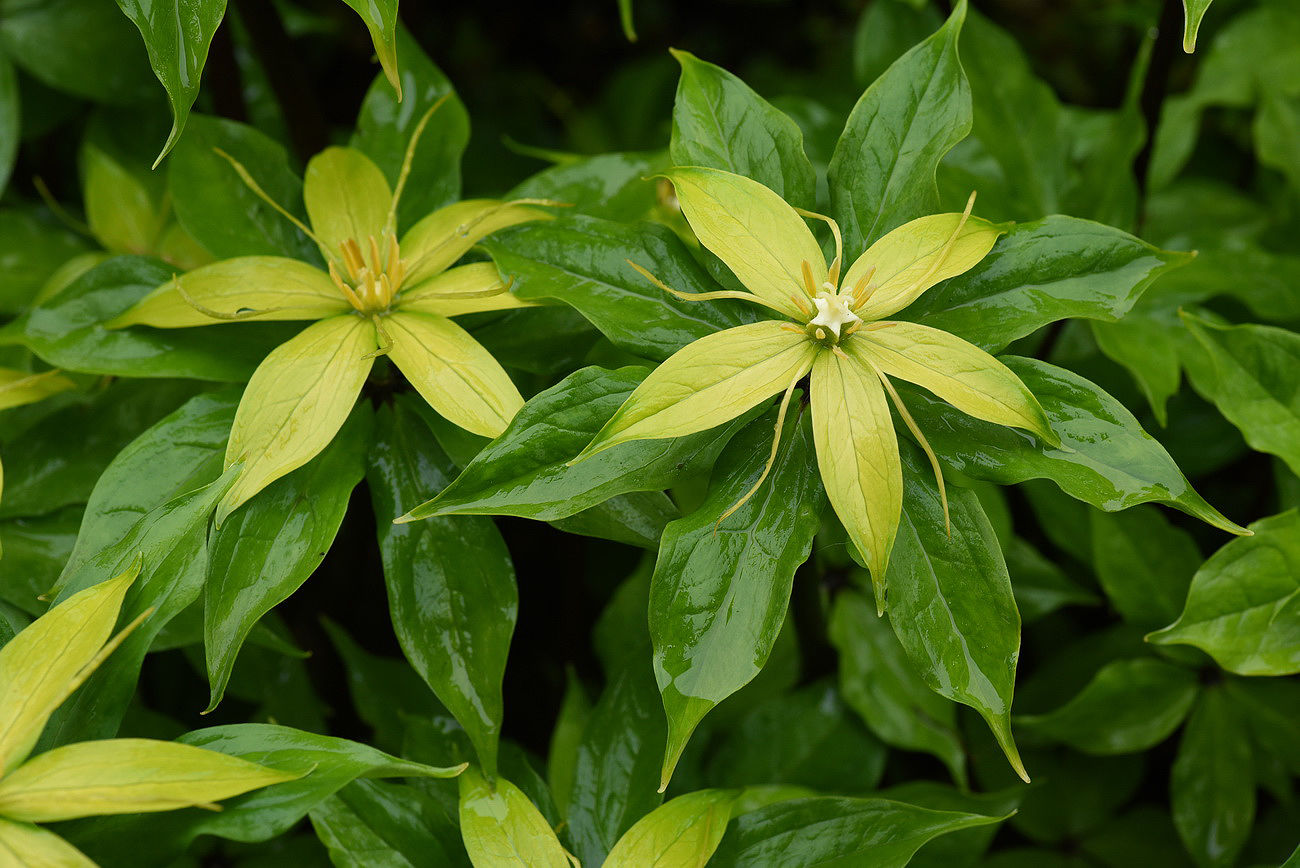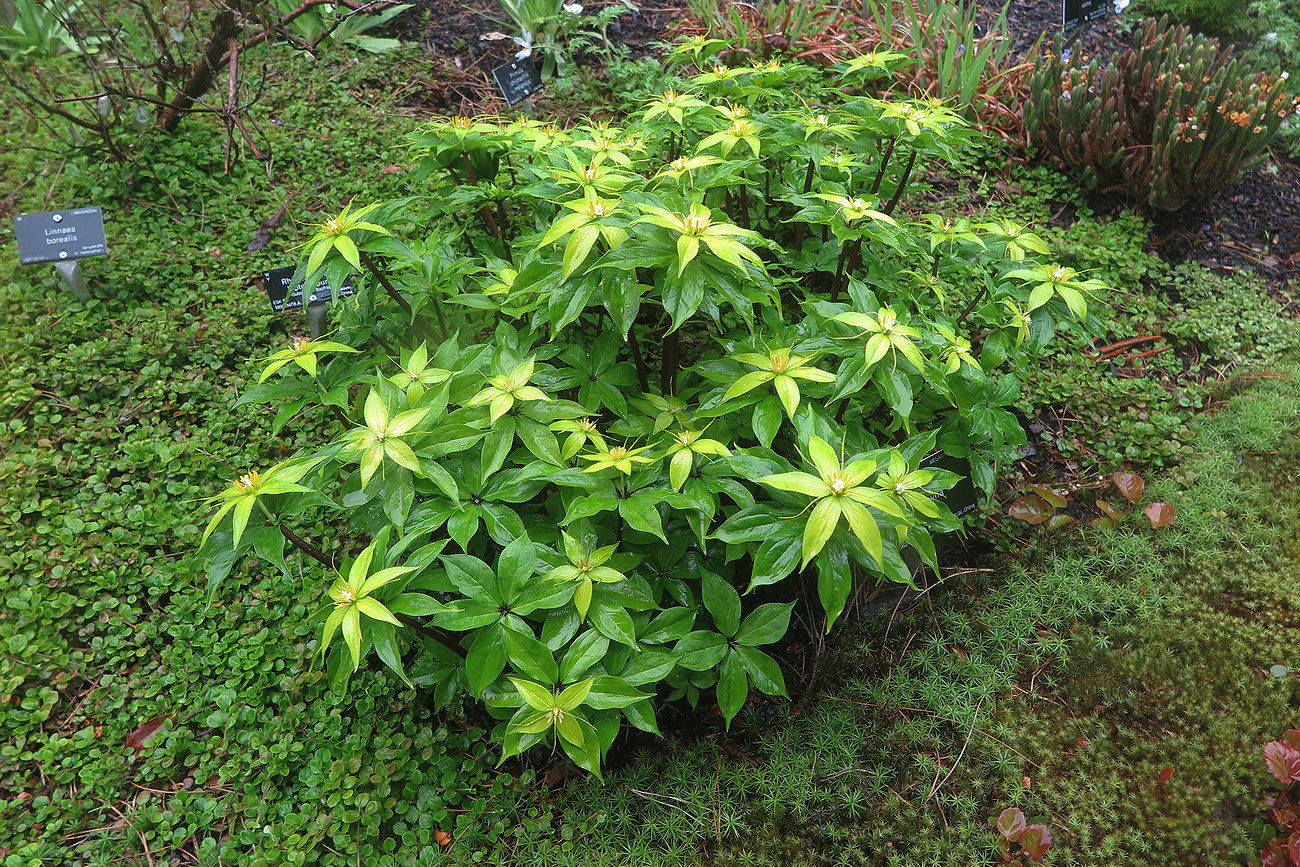Family: Melanthiaceae
Author: Sm.
Bibliography: A. Rees, Cycl. 26: Paris no. 2. 1813
Year: 1813
Status: accepted
Rank: species
Genus: Paris
Vegetable: False
Observations: Himalaya to C. China and N. Myanmar
Description
Love apple, scientifically known as Paris polyphylla, is a prominent species within the Melanthiaceae family. This fascinating plant garners attention not only for its distinctive appearance but also for its widespread presence in diverse regions ranging from the Himalayas to Central China and Northern Myanmar.
Paris polyphylla stands out with its elegant, whorled leaves and unique flowering structure. The plant features a cluster of slender, lance-shaped leaves that circle the stem, creating a striking visual display. Above these leaves, the plant produces a singular, star-shaped flower, characterized by its greenish-yellow petals and contrasting central ovary. This intricate floral architecture not only adds to the plant’s aesthetic appeal but also plays a crucial role in its reproductive process.
Native to high-altitude and forested regions, Paris polyphylla thrives in the humid and temperate climates of the Himalayas, Central China, and Northern Myanmar. These habitats provide the rich, well-drained soils and shaded environments that the plant favors. The Love apple’s adaptation to these specific ecological conditions illustrates its resilience and specialized growth requirements.
As documented by the renowned botanist Sm. in A. Rees’ “Cyclopaedia” (1813), Paris polyphylla has been an object of scientific curiosity for over two centuries. First described in the early 19th century, the plant has since been studied for its medicinal properties and its role in traditional herbal remedies. Various cultures within its native range have utilized the plant for its anti-inflammatory and analgesic properties, highlighting its significance beyond mere horticultural interest.
In addition to its medicinal uses, the Love apple also contributes to the biodiversity of its native regions. It provides habitat and nourishment for various insect species, including specific pollinators that are crucial for its reproduction. Through its ecological interactions and its role in traditional medicine, Paris polyphylla underscores the intricate connections between plants and their environments.
Overall, Paris polyphylla is a plant of notable botanical and cultural significance. Its distinct morphology, ecological adaptability, and historical mentions in scientific literature make it a noteworthy subject for both botanists and horticulture enthusiasts alike. As we continue to explore the rich tapestry of plant life, the Love apple remains a shining example of nature’s complexity and beauty.
Common Names
Swe: himalayaormbär
Eng: love apple
Zho: chonglou, dian chonglou, hua chonglou, qi ye yizhihua
Nep: satuwa
Hin: satwa
Vie: trọnglâunhiềulá
En: Love Apple
Zh: Qi ye yi zhi hua, 七叶一枝花, 七葉一枝花, Chonglou, Dian chonglou, Hua chonglou, Qi ye yizhihua
Hi: Satwa
Ne: Satuwa
Sv: Himalayaormbär
Zh-tw: 七葉一枝花
Th: ตีนฮุ้งดอย
Vi: Trọnglâunhiềulá
Synonyms
- Paris biondii (Pamp.)
- Paris polyphylla var. wallichii (H.Hara)
- Paris polyphylla var. alba (H.Li & R.J.Mitchell)
- Daiswa polyphylla ((Sm.) Raf.)
- Paris debeauxii (H.Lév.)
- Paris daiswus (Buch.-Ham. ex D.Don)
- Paris marchandii (H.Lév.)
Distribution
- Assam (native)
- Bangladesh (native)
- China North-Central (native)
- China South-Central (native)
- East Himalaya (native)
- Myanmar (native)
- Nepal (native)
- Qinghai (native)
- Tibet (native)
- West Himalaya (native)
Additional Images
Leaf
Taken Aug 12, 2020 by Diego Alex (cc-by-sa)
Taken Aug 10, 2020 by Diego Alex (cc-by-sa)
Taken Mar 27, 2020 by Diego Alex (cc-by-sa)
Taken Jun 20, 2020 by philippe de spoelberch (cc-by-sa)
Fruit
Taken Aug 10, 2020 by Diego Alex (cc-by-sa)
Flower
Taken Jun 12, 2022 by Philippe de Spoelberch (cc-by-sa)
Taken Jun 20, 2020 by philippe de spoelberch (cc-by-sa)
Taken Jun 15, 2020 by philippe de spoelberch (cc-by-sa)
Taken Jun 21, 2022 by Melanie Davies (cc-by-sa)
Habit
Taken May 9, 2004 by Royal Botanic Garden Edinburgh – Anthony G. Miller (cc-by-nc)
Taken May 9, 2004 by Royal Botanic Garden Edinburgh – Anthony G. Miller (cc-by-nc)
Taken May 9, 2004 by Royal Botanic Garden Edinburgh – Anthony G. Miller (cc-by-nc)
Taken May 9, 2004 by Royal Botanic Garden Edinburgh – Anthony G. Miller (cc-by-nc)
Taken May 9, 2004 by Royal Botanic Garden Edinburgh – Anthony G. Miller (cc-by-nc)
Other
Taken Sep 18, 1974 by Royal Botanic Garden Edinburgh – Anonymous (cc-by-nc)
Taken Apr 9, 1967 by Royal Botanic Garden Edinburgh – Anonymous (cc-by-nc)
Taken Apr 27, 1931 by Royal Botanic Garden Edinburgh – Anonymous (cc-by-nc)
Taken Apr 24, 1962 by Royal Botanic Garden Edinburgh – Anonymous (cc-by-nc)
Taken Jan 1, 1929 by Royal Botanic Garden Edinburgh – Anonymous (cc-by-nc)

© copyright of the Board of Trustees of the Royal Botanic Gardens, Kew.

© copyright of the Board of Trustees of the Royal Botanic Gardens, Kew.

© copyright of the Board of Trustees of the Royal Botanic Gardens, Kew.
Sources
- WFO (No URL)
- IPNI (No URL)
- GBIF (https://www.gbif.org/species/5295929)
- POWO (http://powo.science.kew.org/taxon/urn:lsid:ipni.org:names:539722-1)
- PlantNet (https://identify.plantnet.org/species/the-plant-list/Paris polyphylla Sm.)



















